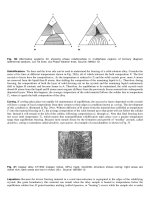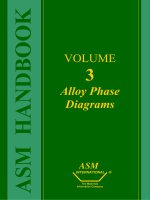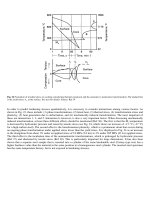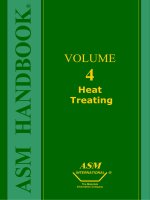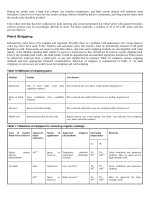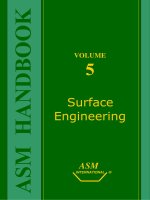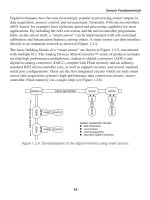Tài liệu ASM Metals HandBook P18 pptx
Bạn đang xem bản rút gọn của tài liệu. Xem và tải ngay bản đầy đủ của tài liệu tại đây (119.07 KB, 10 trang )
(Eq 10)
Because n
2
and n
3
are not affected by the value selected for σ
2
, if σ
2
is to be reduced, the number of strata n
1
sampled
should be reduced while holding n
2
and n
3
constant.
For a fixed total cost c, the optimum values of n
1
, n
2
, and n
3
are:
(Eq 11)
(Eq 12)
(Eq 13)
For this system, the optimum allocation beyond the first stage of sampling is the same for fixed total cost as for fixed total
variance.
Example 1. In sampling a trainload of metal pipe for the percentage of an alloying element, the standard deviation is
0.25 between cars, 0.15 within a car, and 0.08 for a determination. The relative costs of the operation are 5:4:1. The
overall standard deviation σ
o
in the result is not to exceed 0.10.
The optimum sampling scheme is:
(Eq 14)
(Eq 15)
(Eq 16)
Taking n
1
= 11, n
2
= 1, and n
3
= 1,
2
o
σ = 0.25
2
/11 + 0.15
2
/11(1) + 0.08
2
/11(1) (1) =0.008, and σ
o
= 0.09. The cost = (11 ×
5)+ (1 × 4) + (1 × 1) = 60 on the relative scale.
If the costs were fixed at, for example, 40 times that of a single determination on the relative scale, the minimum standard
deviation that could be obtained would be:
(Eq 17)
(Eq 18)
(Eq 19)
Taking n
1
= 5, n
2
= 1, and n
3
= 1, c = (5)(5) + (5)(1)(4) + (5)(1)(1)(1) = 50 and
2
o
σ = 0.25
2
/5 + 0.15
1
/5(1) + 0.08
2
/5(1) (1)
= 0.018, then σ
o
= 0.14.
Calculating Statistical Sampling Uncertainties. Sampling is most important when significant heterogeneity or
segregation exists. When x , s, K
s
, A, and B are known exactly, it is easy to calculate the statistical sampling uncertainty
and to determine the number and size of the samples needed for a given precision. If, as is more usual, these quantities are
known only approximately or not at all, preliminary samples and measurements must be taken, and from these more
precise sampling procedures developed.
References cited in this section
12. H.A. Laitinen and W.E. Harris, Chemical Analysis, McGraw-Hill, 1975, p 576
13. C.A. Bennett and N.L. Franklin, Statistical Analysis in Chemistry and the Chemical Industry, John Wiley &
Sons, 1954, p 62, 482
Sampling
John K. Taylor, Center for Analytical Chemistry, National Bureau of Standards; Byron Kratochvil, Department of Chemistry,
University of Alberta
Practical Aspects of Sampling
Chemical analysis is typically performed on a material that is a subset of some other material or even of a system of
materials of interest. Although the actual sample analyzed may be so small that its ratio to its parent is almost
infinitesimal, for example, a few milligrams of sample as related to thousands of tons of an ore, it must represent the
population of interest.
All aspects of the sample must be considered in relation to the model of the analytical problem (Ref 14). It must be taken
according to a specific strategy, preserved to minimize deterioration, contained to prevent intrusion of foreign substances
or to minimize escape of constituents of interest, processed to retain its integrity, and subsampled as necessary, while
maintaining its correspondence to other members of its immediate family. Because all these aspects cannot be guaranteed,
it may be necessary to analyze a number of subsamples, to perform related measurements to evaluate the magnitude of
any actual or potential complication, or both.
For example, the appearance of a lump of ore under analysis may suggest heterogeneity and that care should be exercised
in sampling it. A sample such as a piece of metal may appear uniform and provide no indication of microheterogeneity.
Even if the material is uniform in structure, different sized particles or chips obtained by crushing or machining may have
significantly different compositions.
Sampling Protocol. The model of the problem and planning of the measurement program should specify the location
of sampling sites, the number of samples required, and how the actual samples are to be taken. There should be no
uncertainty as to what the sample is, which requires that it be taken according to a protocol ideally codeveloped by the
problem-area specialist, the analyst, and a statistician. Therefore, a minimum of these three disciplines must be
represented in planning.
In many cases, such as failure analysis, field examination of the material or structure being analyzed is required. Such on-
site examination frequently reveals information essential to problem solving that may either go undetected or be
permanently lost if the description of the incident and sample-taking are left to personnel who are not familiar with
metallurgical, analytical, and statistical principles.
Mechanism of Field Sampling. Sampling usually requires equipment. Buckets, scoops, or shovels are useful for fluid
or granular materials (Ref 15). Special devices called thieves are used to sample granular materials at various levels
within a container or mound (Ref 15). Dredges, drills, saws, cutting torches, augers, or corers may be needed to obtain
samples from massive materials. In some cases, the sample may be extracted using filters, sieves, or absorption devices. It
may be obtained in a form ready for analysis or may require further extraction or processing in the laboratory.
Samples must be taken in a way that does not influence the measurements to be made. For example, the use of cutting for
removing samples from metal structures for metallographic examination should be avoided, because the heat generated by
cutting can significantly alter the microstructure. If cutting torches must be used, large samples should be taken and
subsequent metallography performed at locations where microstructural alteration from the cuts has not occurred.
Similarly, gas samples must be taken in uncontaminated containers that can be subsequently sealed to prevent material
leakage into or out of the container before analysis. Many incorrect conclusions have been drawn because samples were
altered during sampling. To prevent this, knowledgeable metallurgical and analytical personnel must be involved in
sampling.
Any device used for sampling must conform to the sampling protocol. Sampling devices may have critical dimensions or
operational parameters, such as those used for sampling respirable matter, or filters used to separate "dissolved" or
particulate fractions, or in isokinetic sampling. Failure to conform to critical dimensions or operational parameters can
produce erroneous results. Sampling equipment such as pumps and sieves may require calibration to verify their
performance characteristics at the time of use. Sampling devices ideally should not be made of or contain the analyte of
interest. Therefore, plastic scoops are more suitable when taking metal samples, but metal scoops may be more
appropriate for sampling organic materials.
Preservation of the sample may be required unless it is measured immediately. Changes in sample composition can
result from oxidation, radiation, differential evaporation, loss of volatile constituents, thermally induced degradation, and
interaction with other constituents of the sample or the container. Contamination from airborne dust can be important, and
the introduction of foreign substances can occur. Protection from airborne contamination may require handling of samples
in ultra-clean rooms (Ref 16). Preservation techniques include addition of preservatives, low-temperature storage,
enclosure in inert atmospheres, hermetic sealing, and the use of nonactinic glass or opaque containers.
The concept of holding time can be applied to evaluating preservation techniques. Samples preserved in a given way can
be analyzed periodically to determine the interval that occurs before a tolerable amount of deterioration has taken place. If
this is considered the first indication of significant deterioration, it is equivalent to three standard deviations of the
measurement technique used to evaluate it (corresponding to a confidence level of 95%). If unknown, the standard
deviation of measurement may be evaluated concurrently with the holding time evaluation by duplicate measurement of
subsamples. For some samples, the holding time may be so short as to require field analysis or at least measurement on a
rigid time schedule.
Discrimination. Decisions should be made that define whether certain constituents of a population should be included
or rejected. A particular material may be a foreign object (rejected) or a constituent (included). The model should
anticipate such situations and provide the basis for decision, depending on the use to be made of the data. Thus, sieves
may be specified to separate coarse objects or materials from fines if the former are believed to be foreign.
Moisture. If the original population contains water, the model should define if the analytical result should be reported on
a dry or "as-received" basis. Moisture loss or gain from the time of sampling to analysis also can introduce problems.
When different laboratories treat the question of moisture differently (and sometimes in an unspecified manner), disparity
in results can occur.
The moisture content may not be theoretically defined, but based on arbitrary considerations. Arbitrary drying procedures
must be described or documented. Above all, the basis for the analytical result, such as "as-received," or dried by a
specific procedure, must be stated whenever the moisture content of a sample is a significant consideration (Ref 17).
Because of moisture problems, analytical results on solid materials are frequently reported on a dry-weight basis. The
sample may be dried before analysis, or the wet sample may be analyzed and corrected for its moisture content, which is
measured independently (Ref 17). The nature of the sample may dictate the procedure. Whenever significant volatile
components could be lost, the latter approach may be necessary.
Homogenization or blending procedures may be required in subsampling and field sampling. Because it may
sometimes be difficult or impossible to blend in the field, final homogenization is left to laboratory personnel.
Liquid samples may require only mixing before analysis. However, if immiscible components of differing densities are
present, blending may be required continuously during subsampling. The shape of the container and type of mixer may be
important in ensuring a proper blending of the constituents.
When the sample contains liquid and solid constituents, the phases may be separated and analyzed separately, in which
case the amount and the composition of each phase present may need to be known. Complete separation of the phases
could be a problem, and the definition of dissolved and suspended matter may be arbitrary, for example, based on
separability by a filter of specified porosity. Filtered solids may contain absorbed or occluded liquids that may be difficult
to remove. The alternative of analyzing a suspension could cause even greater problems if any difficulties of maintaining
suspendibility are expected.
Blending of heterogeneous solids is frequently performed. Such samples are often crushed to obtain small particle sizes
that promote improved mixing. Crushers can range from the familiar mortar and pestle to specially designed mills. They
must be made of noncontaminating materials harder than the materials processed to minimize abrasion and should have
chemical resistivity to the samples. The fineness of grinding required will depend on the heterogeneity of the sample, but
fine grinding is ordinarily preferred. Sieving may be performed at intermediate stages to separate fines and coarses that
are later reground. When the coarses differ in composition from the fines, each may be ground using a different process,
then combined to compose the analytical sample.
The grinding of soft materials, especially those with appreciable water content, may require special grinders. Special mills
have been developed for such materials as food samples and feeds. Cryogenic grinding and blending may also be used
(Ref 18). In such cases, prevention of condensation of atmospheric moisture may be a problem. Caking and electrostatic
clinging of material to parts of grinders and blenders can cause mixing problems as well.
Blending is often necessary after grinding. Blenders include rifflers in which the sample emerges from a container in
preset fractions. Cone and V-blenders have been designed for mixing materials. Cones are often double and joined at their
bases. Rotation produces swirling or tumbling. V-blenders achieve the same result by alternately pouring their contents
from one arm to the other as the device is rotated. For best results, mixers should not be overloaded and should be
operated slowly enough to produce alternate interchanges of the contents. Holdup due to caking can decrease their
efficiency. The number of cycles required must be determined empirically.
In the simple process of quartering, the sample is placed on a sheet of suitable material, and alternate edges are pulled
together to achieve mixing. Shoveling from the edges of a cone of material to the top is sometimes effective.
References cited in this section
14. J.K. Taylor, Quality Assurance of Chemical Measurements, Anal. Chem., Vol 53, 1981, p 1588A-1595A
15. C.A. Bicking, in Treatise on Analytical Chemistry, 2nd ed., Vol 1, I.M. Kolthoff and P.J. Elving, Ed., John
Wiley & Sons, 1979, p 299-359
16. J.R. Moody, NBS Clean Laboratories for Trace Elemental Analysis, Anal. Chem., Vol 54, 1982, p 1358A-
1376A
17. "Standard Practice for Preparation of Sediment Samples for Chemical Analysis," D 3976, Annual Book of
ASTM Standards, ASTM, Philadelphia, 1984, p 673-676
18. R. Zeisler, J.K. Langland, and S.H. Harrison, Chemical Homogenization of Biological Tissues, Anal.
Chem., Vol 55, 1983, p 2431
Sampling
John K. Taylor, Center for Analytical Chemistry, National Bureau of Standards; Byron Kratochvil, Department of Chemistry,
University of Alberta
Quality Assurance for Sampling
Many sampling errors can be eliminated or minimized by an appropriate quality-assurance program (Ref 19). Quality
control may be achieved by following standard operating procedures and recommended laboratory and measurement
practices. Protocols should be developed as part of the planning program to define how each aspect of sampling will be
executed. They should specify related calibration procedures and schedules and provide for controls such as field blanks
and for the container cleaning process.
Training of personnel should provide a thorough knowledge of the elementary statistics of sampling. Specific training
should be devoted to the operation concerned with each specific measurement program, including a thorough review of
the protocols to be followed. Critical steps should be identified and explained, and any special documentation reviewed.
Sample uncertainties, random or systematic, result from the sample or from the sampling operation. Population-
related variability has been discussed above. However, unless the entire sample is analyzed, a subsample may be required
that may have some of the problems encountered in the original considerations. Thus, subsampling may be considered as
sampling the sample. Unless proven otherwise, subsampling error should be assumed to be present (Ref 20).
Sampling can introduce uncertainties superimposed on that of the sample variability. Faulty calibration of sampling
equipment, introduction of contamination, malfunction of equipment, and differences between equipment used can
introduce systematic errors, and variation of these factors can produce random errors.
Rigorous cleaning of equipment between samples may be necessary to minimize error from contamination or carryover
problems. Evaluating the effectiveness of cleaning may be difficult. Containment may contribute to contamination,
especially in trace analysis. Virgin containers usually require cleaning. If containers are to be reused, cleaning may need
to be monitored. It may be necessary to restrict reuse to a certain class of samples and even to restricted levels within such
classes if memory or cross contamination is a possibility.
Rigid calibration programs and checks may be necessary to ensure proper functioning of some sampling equipment. If
calibration is performed in the laboratory, periodic field checks may be required to confirm retention of calibration,
especially if the usage is severe.
Sample Identification. Definite procedures may be required to ensure the identity of samples that are analyzed. Well-
designed labels can document the details of sample location and of the sampling operation. Critical aspects of their
transport and storage can also be attested. Breakage-proof containers and tamper-proof closures may be required. A
sample custodian may be necessary in some cases. There should be no reasonable doubt about the identity and the
integrity of any sample analyzed.


